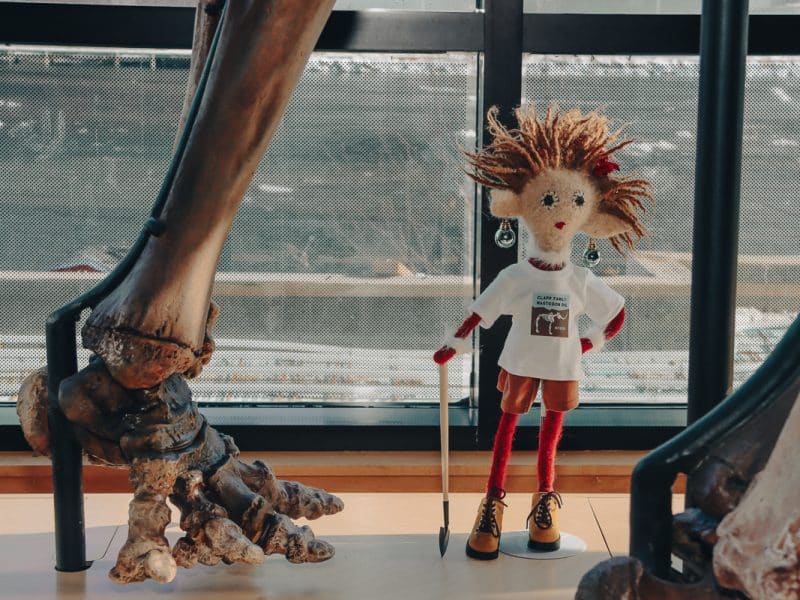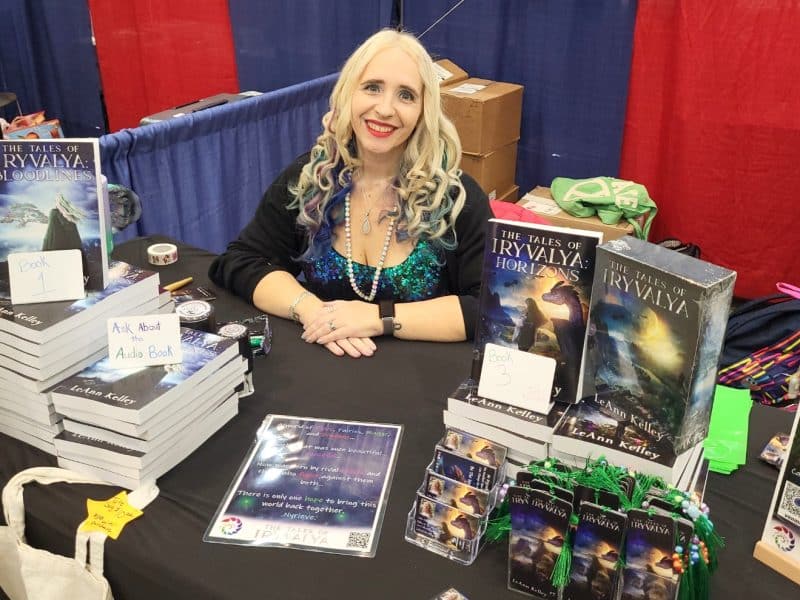Pat Perry: A gentle giant of art and design
Pat Perry is one of the more interesting people that publisher Tommy Allen has met in this world. Enjoy this conversation with a truly remarkable artist from Michigan.

It has been years since artist Pat Perry and I last had a chance to speak face-to-face at the UICA. He was in town with the touring artist group the Beehive Design Collective, who were showcasing their anthropologically-focused works to a packed room.
From there if I wanted to keep in touch with his career path, I would have to follow him via his Instagram account at heypatyeah as he toured the nation through various means of transportation and almost always on roads few would venture.
As this former Grand Rapid resident and Kendall College of Art and Design student would criss-cross the world, he would take up formal residencies, like his National Parks Service one in Alaska, or those informal ones, which would appear to be anyplace Perry chose to stop along his journey. Through all his works Perry has remained a bit of a quiet force of visual strength wrapped up in thoughtful mystery.

Perry recently bought a home in Detroit and in putting down roots has been quietly working over the last two years on a new suite of large paintings that reflect the artist’s distinct style of observation. From the preview I received, I can safely say these new works expand upon Perry’s visual lexicon for taking the ordinary and lifting it up in a manner that is neither judgmental nor mellow-dramatic — both traps that any artist knows is easy to fall into when addressing such imagery.
He is one of the more interesting people that I have met in this world. So when Rapid Growth’s Editor Lauren Fay Carlson was preparing our issue on design, she asked who I wanted to write about. There was only one choice for me.
(To follow is an interview with the artist Pat Perry. It has been edited from its original format for flow.)
________________________________________
Tommy Allen: I understand from other interviews you’ve given over the years that you’re resistant to talking about train hopping. And yet, since this style of traveling is almost as old as the invention of the locomotive, are you still hopping on freight cars to see the country?
Pat Perry: Sometimes. I mean, I still love to do it. Obviously, it’s a little different when you live in a house and have that. It’s something I still care about, but I never wanted my art stuff to be centered around it. It’s something I love, but it’s also not something I feel like I need to put in the spotlight as if it is a part of my identity. Trains are my favorite thing. I’m a total nerd about it.
TA: Judging by the long history of hopping on a train, you’re not alone. Many thousands spanning as far back to the expansion of the western territories and the Civil War have engaged in this activity. It sounds like now you probably view it now as more of an option when considering your transportation matters.
PP: The thing that I like about train hopping most is the perspective that you get to see from it. The situations you find yourself in where you’re all of a sudden somewhere you normally would never go. When you see things because you have to, from a specific angle like that, I think it gives you a different perspective as to what’s going on. And then there are the people you meet.
But this happens all the time in Detroit in the same way. I think it’s just like trying to find practical ways throughout your life to place yourself in situations that illuminate things for you.
TA: But at the same time, possibly it says a lot about those folks who are fascinated by train hopping. I have to believe that some folks are also projecting their own longing for adventure or the un-mappable journey.
PP: Yeah, totally. Travel is an example of something that takes place in many different forms. But when talking about travel, specifically one has to wonder, how do you travel in a way where it’s not gonna be the same story over and over and over again?
TA: I think what we’re talking about is the well worn paths we all build into our daily lives. They can be monotonous or produce numbing to the senses through familiarity.
PP: You go to the same exit on every highway when you take your road trip with your friends—and you know it’s gonna be super fun—but along the way there’s the same Love’s Truck Stops, the same Burger Kings, the same signs over and over again no matter where you go.
It’s like everywhere you go is the same. That’s the scariest part. And that’s what’s depressing about traveling to me, too, especially in America, is its constant sameness. You can go to Arizona, and you’ll have the exact same food options as when you were here.
TA: Sounds like a narrative from the book “The Accidental Tourist.” You’ve just described why I have grown to not enjoy Manhattan anymore. Everything on every corner is reflective of something I can find in nearly every town now as everything I loved is evicted or closed down.
PP: I think the thing with travel for me, whether it be riding trains or hitchhiking, is I want to feel like I am in the shadows. You are on your own, keeping a distance as you’re travel on the edge of town. You’re doing it, but you’re not infiltrating that place.
Also, when you have less resources that you’re traveling with, people tend to be more open to you. When I was traveling alone, people would offer assistance like, “There’s just one kid there. They wonder what’s that kid doing? Maybe I can help him.”
TA: People are at that level, I have found on my own journey, to be the most generous of spirit but also inquisitive for sure….
PP: …And the interesting thing is that the people who would always extend a hand to help you are the people who are always on the lower end of the (societal) totem pole. I wouldn’t have guessed that.
TA: So is the travel you have experienced a form of diving into a culture?
PP: “Dive into a culture” makes me think, like “mingle with the locals.”
TA: Oh, no. I don’t wanna make it seem you’re a tourist.
PP: No, but I also think it’s like a certain brand of tourism to try to not be a tourist right now. It’s all being marketed, like, “Come mingle with the locals and have the most authentic experience.”
TA: Let’s pivot to your beautiful site-specific piece you created in the Canadian town of Churchill.
PP: That project was a situation where a small town sought out artists to help transition their economy from a declining port city to become a tourist destination. It was a pretty rugged town filled with hardworking people who needed to be tough to even survive way up there.
(Publisher’s timeline note: The tiny Churchill community had been working over the prior year on their plans with the artists. However, before the artists would arrive in the community to begin their art pieces, the town would experience a devastating flood washing out the main railroad line used by the already waning port. The locals would learn that the rail line would not replaced, thus accelerating an already economically depressed region as it plunged the already cut-off community into a time of rising prices, starvation for animals, and the reality that their town may go extinct very soon. You can read Perry’s insightful letter about the project here.)
TA: I imagine that when you finally arrived even the prospect of making art must have been viewed as a futile gesture. How were the locals?

PP: I felt really welcomed and at home in this community that was going through a rough point in their history. The folks of Churchill just felt like they were on the same level as us. They all wanted to help with the projects that we were there to complete and I needed them, I needed help. And when you have to ask folks for help, I think it’s like a good way to bond.
TA: And they had to have known once the railroad line, this economic lifeline, was not going to be replaced, that their fate was sealed as they stared down an extinction of their community now cut off from the economy that shaped their town over the years.
PP: Something changed with that [realization]. We had to ask ourselves (and as the letter illustrates) why go up to this town to do an art project, when these people needed real help?
And I love the arts. It’s my vocation. But when people are in a crisis, we didn’t want to go up to Churchill to do just a cool art project. It just feels a little silly at a certain point once you consider Maslow’s hierarchy of needs and the plight of these citizens.
TA: You must have had a lot of questions as you prepared to arrive in Churchill.
PA: Yes, like, “Why am I up here doing this painting project?” And, “Why are we hauling paint up here in this scenario?” So, the only way I felt like—to placate those concerns was to make something that felt like it was really acknowledging what was going on and had that in mind.
TA: To toss out the original plan for the airplane site and let another narrative or idea evolve seems appropriate, but also can be scary.

PA: That’s why I tried to weave that into the whole story of what a plane crash is symbolic of and what the whole message of that was reflective of. I think in the end that is why I didn’t paint something more jovial. I didn’t paint like cute polar bears, (which are indigenous to Churchill.) It is why after meeting with the residents to listen to their concerns that I painted something that was pretty dark, and the whole thing was, is because there are existential threats all around us.
TA: So the piece is about the place but also something we can all see happening in other pockets of the world, too. I have read that the project was well-received, which I believe points to the role of artists often as apt communicators of our present tension. How did the level of this project raise awareness and what is next?
PP: There was definitely some coverage. They even shot a Canadian Broadcasting Corporation documentary about it while we were there and it’s supposed to come out very soon. I don’t know what it’s gonna do for greater awareness, but I think that—and I don’t wanna speak for all the artists that worked on this one, but I think a lot of them had the same ideas in mind and did a good job at trying to just make the people feel heard and acknowledged in what’s going on.
I think that the folks of Churchill want to feel like someone’s listening and that we weren’t just like chickens running around with our heads cut off. We were paying attention and were down to be reverent to this situation.
TA: I detect a bit of an influence from your time spent touring the country with the Beehive Design Collective. Did they have an impact on the development of your listening skills?
PP: A lot. If I could sum it up—I doubt I can do this — but, if I could sum it up I would say I didn’t know what I was doing [when you and I met back years at Art Battle in Creston.] I was exploring lots of different things, as everyone does when starting off.
Throughout those years, before working with the Beehive, throughout working with them, and then since thereafter, I’ve cut my teeth politically.
What I’m just realizing now—and after considering how confusing and complex the times can be—is that when it comes to art, there’s a problem with didactic work where you’re trying to teach the audience something that you think you know.
TA: Truthfully? You are addressing something all of us artists who work in this space must consider before committing to the path, pen, or paint.
PP: It’s not that you don’t know your material or that that’s not a noble pursuit, but it’s just not going to work. It’s not a good way to frame the whole art process, even if you feel like there’s something that desperately needs to be known. I could make some paintings that were really strong statements that were obvious, that were like some bash on corporate culture, mono-crops, Big Ag, or institutionalized racism. But if you’re too crass about it, people will just quickly identify it for what they know it to be because they’ve heard it all before, and then it is “goodbye.”
TA: You have just described what I have experienced with folks who view art at a gallop, never pausing long enough to ponder its hidden language or deeper meanings. Speaking of slowing down a bit, your massive new body of work has been quietly forming in the background over two years. That seems like a long time considering the art market we presently know exists to “pop” new ideas quickly to capture an audience you already clearly have when I review your social spaces for your works.
PP: We’re not in a situation, in the art sphere, to gain any kinda traction if you’re only gonna put stuff out that takes a long time. That does not fit the format of the way things are going right now. And it is totally possible that that’s gonna hurt the ability for this work to be seen or appreciated.
TA: I am assuming, after seeing this very expansive collection of new works from your travels, that you must have a strong desire to keep the new body of art together for as long as possible to retain its meaning through its collective impact.
PP: That’s all something that concerns me often. But also, what my friend Colin told me, and what I think is I just have to remind myself, “You can’t think about that.” My only job is to make the best stuff that I can, and if that’s the way that I think it’s got to be, then the work is gonna be the best. All you are supposed to do is just honor that path. You really can’t worry about how it’s going to come off, or that you weren’t fast enough, or you weren’t cavalier enough or tenacious enough with it. You just have to follow your heart.
TA: Giving space to listen to what’s in you is a step in crafting that much-needed balance.
PP: It’s so easy to get caught up just talking about the making of the work and the process of creating, but also, I invest a lot of time and energy into being, shaping the person I am to the people and to the community closest around me and my personal life. I’ve felt more inclined to keep that side of me more private, as things go forward.
(Note: Before moving into his Detroit home that had sat empty for more than 20 years, Perry went around the neighborhood asking his community’s residents if they were “ok” with him becoming their neighbor. He would employ this technique of communicating with his community again as he prepared his second wall art piece for the 2017 Murals in the Market.)
PP: I spend a lot of my time outside of creating more artwork or fixing this house. Instead, I help my friends with their projects, and in doing so I get to make my personal life exemplary in the way that I think is reflected in the virtues I try to show in my work.
Because I hope that when I die or when I’m not around—however you wanna say it—that when someone views the work and they discover the things that maybe my art was trying to say and what virtues it represents, then when they look at me as a person, then those things are not contradictory.
As a close friend of mine once remarked, “Sometimes I forget you even do art. I just am happy with the person you are.” That was like a really great thing to hear someone say.
TA: Our present history can be hard and downright depressing at times that to hear those affirmations can be transformative. But we can also sound odd as artists when we try and vocalize such ideas of reconciling our art with our actual person.
PP: I don’t want it all to be so abstract, but I still feel really idealistic about making art. I really believe in it, and I think that that has been unwavering. I feel more motivated than ever, because I think it’s the most exciting time ever to be making art and trying to do it in a really eloquent and beautiful way.
After several years of being a full-time artist, I am trying to be as careful as I was in the beginning about not getting an ego about it while trying to create the work. I try to live a lifestyle that is conducive to making my art.
To learn more about Perry’s work, please visit his website. In 2013 Perry was interviewed by Victoria Mullen for Rapid Growth. you can read that story here.








